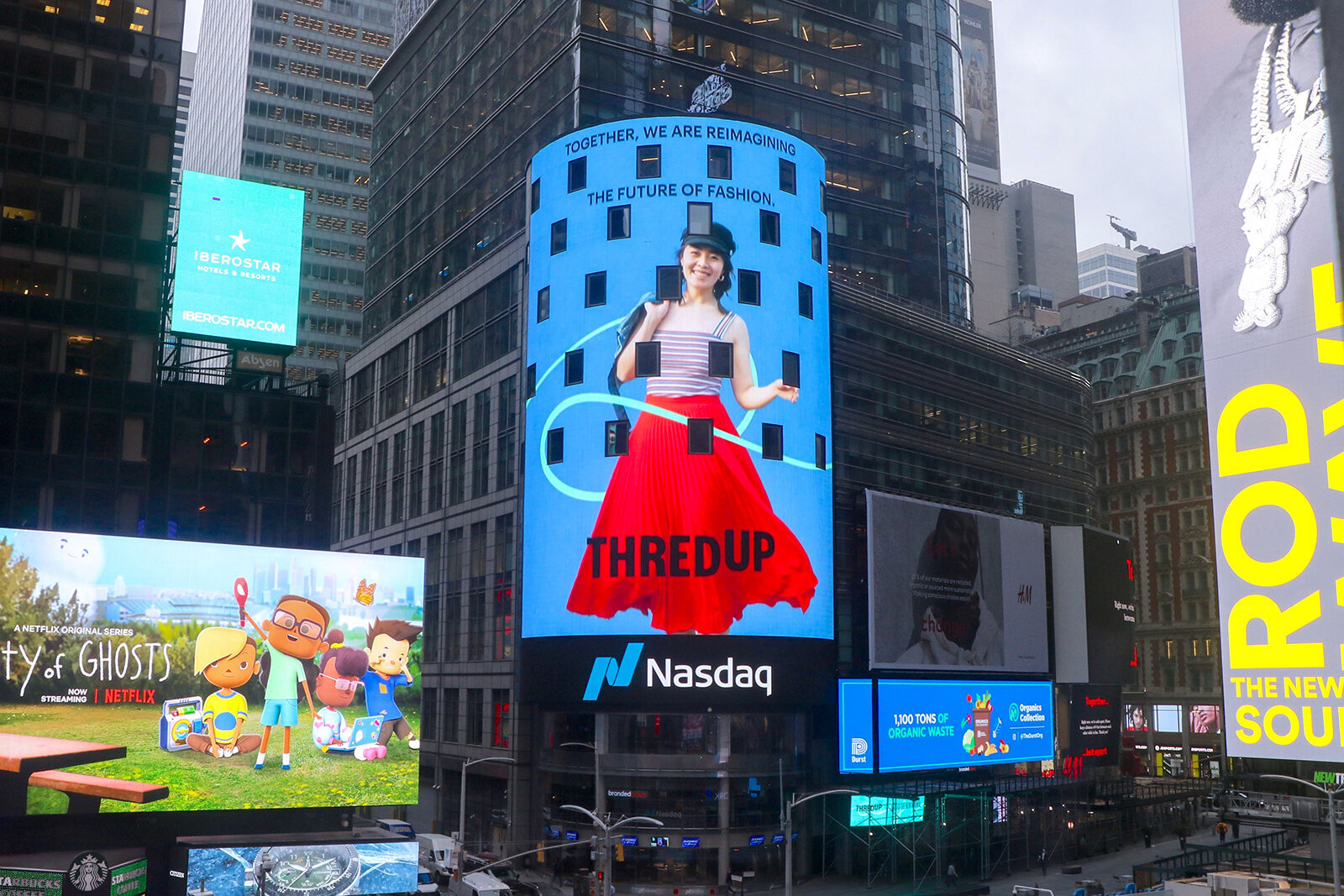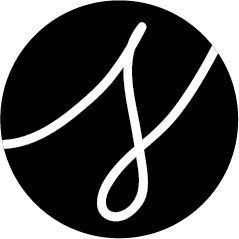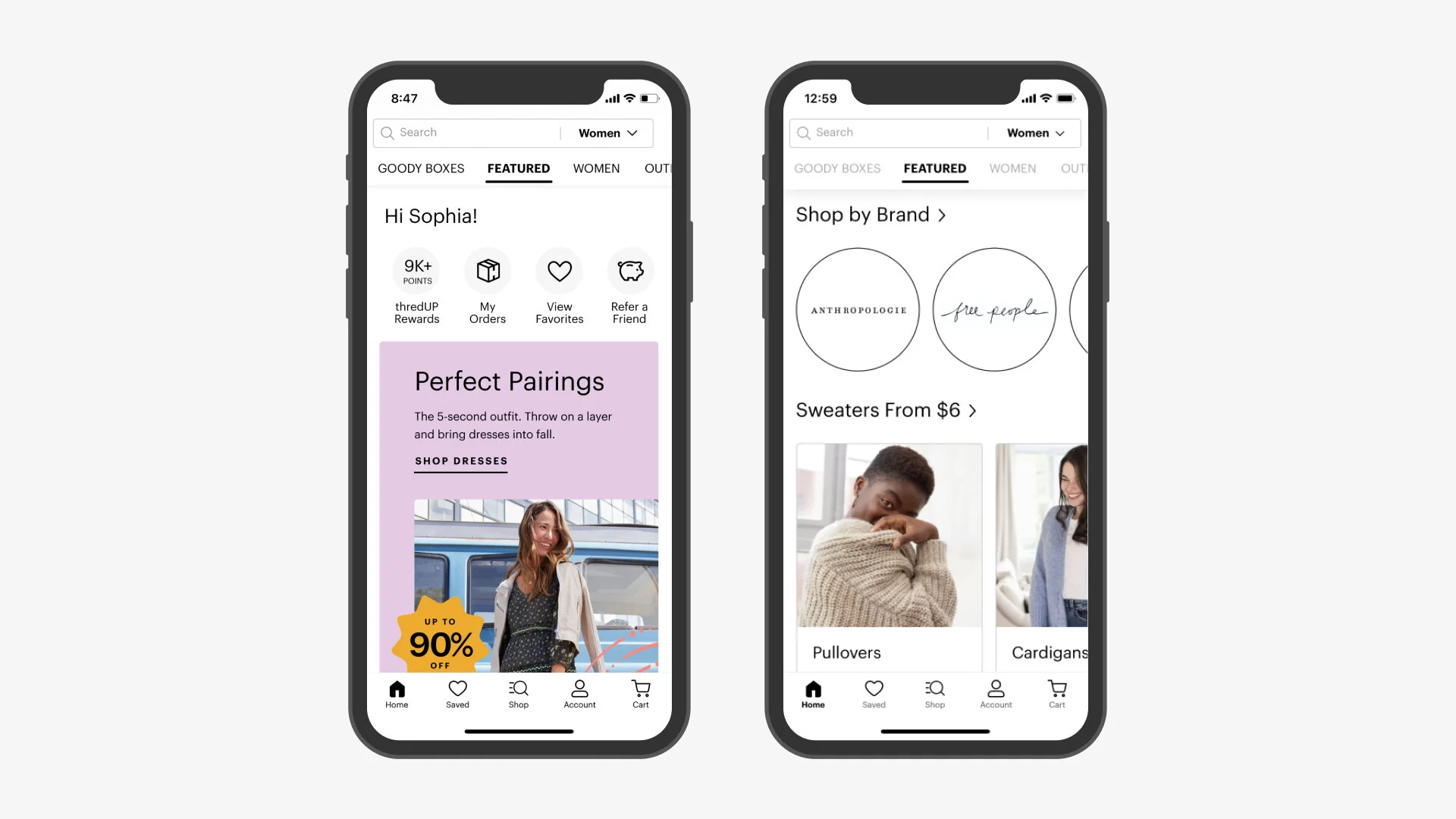
My Work at ThredUP
The world’s largest fashion resale marketplace, ThredUP is a fashion e-commerce site focusing on secondhand clothing. As a product designer, my job is unique in the way our product is unique. We seek to create and expand a platform that provides a convenient selling and shopping experience for a wide range of customers. My work includes:
💡PRODUCT
Partnering with product and engineering teams to develop and refine web and mobile products.
🎨 DESIGN
Leading user experience, visual, and interaction design of new features, products, and systems.
🔨 Optimize
Ensuring consistency by building a design system. Standardizing our design process to create efficient workflows.
What types of projects do you work on?
I work on the customer-facing core marketplace side of our business, where I support the growth team, the search and discovery team, and the retention team. Because our product design team is small, I split my time between a range of projects. One quarter I may be designing a new loyalty program, and another quarter I may be overhauling our entire search experience. I’ve led a homepage redesign, worked on new experimental shopping tools, and supported a company rebrand leading up to our IPO.
Lately I’ve taken a more active role in building and optimizing design processes and workflows. I championed our transition to Figma, helped start a design system, and worked closely with developers to design and build out our first internal content management system.
What’s your role on the product team?
ThredUP’s product team owns the P&L. As a marketplace with a single SKU operation and a heavy dependency on operations, ThredUP is a challenging business. Product managers are held accountable for business performance, which means my work makes a direct impact. As designers, we work closely with the PMs to think about problem spaces, analyze data, and develop products. Even though we’re now a public company, we stay scrappy and make fast-paced data-driven decisions. We’re continuously iterating, testing, analyzing results, shifting priorities, and learning to improve. As a product designer, I get visibility into business goals and metrics, and have the incredible opportunity to lead projects, develop solutions, and directly contribute to growth.
What are some challenges?
As a designer, it’s exciting to be involved in so much, and on any given day you can always find me working on multiple projects at once. I thrive in an environment that is constantly evolving, and the speed at which our priorities shift challenges me to be resilient and many times wear multiple hats. I’m constantly trying to strike a balance between the product side of my role and the design side. Because we tend to focus on business initiatives, I have to make sure to push for good user experience when developing a new feature, and advocate for clarity and transparency for our customers. And when things seems to be moving a bit too quickly, evangelize the importance of qualitative research and validation.
What’s your favorite part of your job?
Besides working with really smart people and building a product I personally use and love, my favorite part of what I do is designing for reuse. Obviously ThredUP’s mission is to reuse and recycle clothing, but in my work, I’ve found a passion for the design of reusable elements, components, patterns, that can scale and adapt for future change. Instead of building features, I aim to build systems that are flexible, versatile, and can outlive my time here. My homepage redesign and Thrift the Look projects are two examples of successful systems that have scaled within the company and taken on a life of their own.
Also, who doesn’t love telling their friends that the work they do everyday literally saves the environment? I accidentally become a climate designer and I couldn’t be more proud.
Presenting my project at one of our internal quarterly hackathons, alongside developers from our Ukraine office.
My Process
What’s your background?
I have a degree in architecture. It’s not a Bachelor of Art or Science, but a hybrid Bachelor of Architecture that nurtures technical skill, research, and creativity. Architects are jacks of all trades. They work with stakeholders to gather ethnographic information and transform a space into a beautiful and practical form that develops a relationship with people and their surroundings. Similarly, product design is also a holistic discipline, a highly iterative process that allows designers to deliver experiences and solutions for people. Whether I’m designing a soccer academy or an app onboarding experience, I go through the same design process, where I research with empathy, communicate with clients and users, solve problems, think systematically, and build experiences.
How do you go about a new project?
Listening. My creative process starts with gathering as much context as possible by truly listening and defining the problem. I need to understand what we're trying to solve, and why, and what we hope to get out of the finished product, whether it's solving an specific pain point or growing our user base. I talk to the PMs, clarify the business motives, and chat about a range of ways to approach and reframe the problem. The longer I work in this field, the more I realize that design begins not in Figma, but a word doc.
Then we move into my favorite part of the design process: ideation. This is the stage where I get to think blue-sky, dream up innovative solutions, and be engrossed in the customer experience and journey. I try to bring in engineering input not long after to get an understanding of scope and engineering effort, and as well as additional design input. (Many times, engineers are the ones coming up with the best ideas!)
User testing and iteration are the meat and potatoes of the design process. Validating value, usability, and feasibility are vital to the success of the product, and I truly love taking the time to talk to our customers face-to-face to do so. Some prototypes and specs later, we’re ready for hand off.
What happens after a project ships?
In our agile world, a project is never really done. If an A/B test fails to perform, we brainstorm different solutions using those learnings. If we measure significant improvement in KPIs, we make plans to update other platforms. Most of the time, because our initial tests are lightweight and small scale, we have the flexibility to keep iterating and testing. With the amount of ideas we want to try, there’s never a dull moment. I love it.
From a design documentation side, I’ve been a big advocate for building a design system. Because we’re always thinking about so many different projects at once, I want to document our design decisions and define a library of guidelines and components that streamline our design and development workflow. I want to unify the language designers and developers speak, and focus our efforts on building a great product rather than trying to investigate what shade of red our alerts should be.
Taking my coworkers out to draw downtown San Francisco, during our annual company conference. My creative process always starts on pen and paper.
My Projects
Enough talk, why don’t I show you some of my work? This portfolio contains case studies of larger projects I’ve worked on and owned, ranging from new features to redesigns to systems.
My work is done in collaboration with our product design team (Director of Product Design Karen Wei and Senior Product Designer Sarah Olson). I also work closely with the product management and creative marketing teams to conceptualize and design.












A new loyalty program for all thredUP customers.